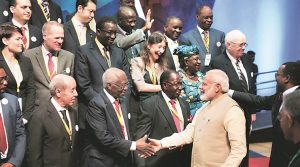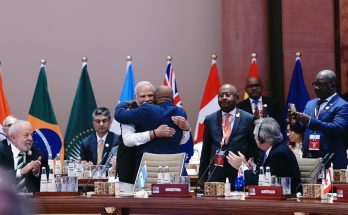As Africa realises its promise and intensifies its ongoing resurgence and India finds its voice on the global stage, competition with other players, including China, will be inescapable
It’s time for Africa, and Africa’s turn to bask in the global spotlight as the BRICS summit of emerging powers hosts an outreach meeting with the leaders of many African countries in Johannesburg this week. Ahead of the BRICS summit, the leaders of India and China will launch a “Charm Africa”, diplomatic mission, with both Prime Minister Narendra Modi and Chinese President Xi Jinping travelling to Rwanda, a landlocked country with not many resources, but full of can-do spirit to fashion the country’s destiny anew. Besides Rwanda, Modi will be visiting Uganda and South Africa and Xi Jinping will travel to Senegal, South Africa and Mauritius.

Neo-scramble for Africa?
Back-to-back visits by the leaders of India and China to African countries is bound to fuel speculation about competition and rivalry for a resurgent African continent, which is expected to grow at the rate of over four per cent and is moving up the global radar screen. It’s tempting and easy to fall for this facile Western construct of India-China competition for Africa, but the reality of a rising continent is more complex than such clichés can subsume.
For one thing, Africa is big enough, both in terms of geographical size and sheer scale of its ever-growing development needs, to absorb more external players. For another, this narrative of Africa as the chessboard for great and not-so-great powers reek of a neo-colonialism mindset which should be eschewed.
Africa has moved from the unenviable position of having no takers, a hopeless continent, as depicted in the May 2000 cover of The Economist to a geography of opportunity, a rising continent with more suitors to choose from. What it adds up to is that the ongoing transformation of Africa, home to six of the world’s fastest growing economies, offers new opportunities to all its traditional and emerging powers to up their game and proactively participate in the continent’s economic and development journey, with their unique strengths and capacities. Africa will judge its partners by what it brings to the table.

What’s on the table?
So, what’s on the table during Prime Minister Narendra Modi’s visit to Rwanda, Uganda and South Africa? What can he achieve in five days and nights he will spend on the African soil? In a networked world, bristling with competing narratives and fake news, Modi should use this opportunity to brand India’s multifarious engagement with Africa and raise the bar.
Historical and cultural ties will find reflection in his remarks and speeches in Kigali, Kampala and Johannesburg, but rather than luxuriate in the safety of these clichés, he should focus on the future of this dynamic partnership of mutual resurgence. Africa is an overwhelmingly young continent — more than 60 per cent of its population is in 20-35 age group — it’s time to link India’s growing engagement with Africa to surging aspiration and dreams of its young people. In his speech to the Ugandan Parliament, Modi will get this opportunity to articulate afresh distinguishing features of India’s engagement with Africa. The speech will be telecast live not only in Uganda and India, but people in other capitals of African countries will also be tuning in.
Walking the talk

At IAFS-III, India raised the bar by moving beyond the constraints of the Banjul Formula to host the leaders and representatives of all 54 African countries and pledged $10 billion in lines of credit (LOC) for a wide array of development projects in the continent. Nearly three years down the line, around $3.5 billion LOC has been disbursed. With two years to go for the next India-Africa summit, it’s time to fast-track identification of projects, followed by swift implementation.
Development cooperation, within the ambit of South-South solidarity, after all, forms the heart of India-Africa partnership. In Kigali and Kampala, India is set to announce new LOCs for varied development projects worth around $400 million. Training and capacity building, the twin strengths of India’s partnership with Africa, will also be telescoped during Prime Minister Modi’s visit to Africa. This demand-driven consensual development partnership is what sets India’s engagement with Africa apart and need to be bolstered with quicker delivery of projects.
Diplomatic outreach

Narendra Modi’s visit to the three African countries marks a qualitative and quantitative upgrade in India’s diplomatic outreach, which has acquired scale, speed and skill in the last four years. Starting from his maiden visits to Mauritius and Seychelles in March 2015, followed by the four-nation visit to Kenya, Tanzania, Mozambique and South Africa in July 2016, Modi will have visited nine African countries. This is three times more than the number of African countries his predecessor visited in his 10-year stint.
Put together, 23 high-profile visits at the level of Prime Minister, President and Vice President to Africa have taken place, making the last four years a high watermark in India’s diplomatic outreach to Africa. This unprecedented diplomatic outreach is commendable but it’s time to marry it with greater economic content and strategic connect.
No risk, no gain
In economic terms, the relationship remains severely underleveraged, with bilateral trade still hovering around $70 billion. It’s time to raise the sights as this figure can be doubled by 2020 through a mix of focused policy changes and promotional strategy. The good news is that more Indian companies are looking at Africa as a Cape of Good Hope, but their perception still remains mired more in risks than in opportunities, which is out of sync with the emerging shift in the narrative of Africa from the risks of doing business to the risks of not being there. The Government should vigorously promote Africa as an investment destination; and Indian companies should shed risk aversion to seize new opportunities emerging in a rising continent.
Comparisons can be odious but India Inc. needs to show more appetite for risk if India’s bilateral trade is to come anywhere close to China-Africa trade, which has already exceeded $220 billion. In this regard, the conclusion of the first phase of African Continental Free Trade Area AfCFTA negotiations promises to be a game-changer as the free trade area will encompass a market of 1.2 billion people and a GDP of $2.5 trillion across all 54 members of the African Union.
Strategic connect
Strategically, Africa is poised to become more important, especially in the age of the Trump unpredictability and the proliferation of cross-cutting security challenges. It’s time for India to focus on providing more substance to its strategic partnership with the 54-nation continent. From combating maritime piracy and terrorism to realising UNSC expansion and protecting the rules-based international order, having Africa on board will be a strategic necessity, not a choice in a world riven by rising unilateralism and nationalism.
As India and Africa raise ambition for their partnership, promoting regional connectivity and integration will be a game-changer. Connectivity should not, however, become an arena of contest as many African countries are signing on to China-backed Belt and Road Initiative. Given the scale and history of its engagement with Africa, India has mapped its own narrative of trans-regional connectivity. Asia Africa Growth Corridor is an idea, whose time has come, as Prime Minister Narendra Modi has said.
TIES: Interlinked resurgence

Looking ahead, simultaneous economic resurgence of India and Africa, home to over 2.5 billion people, is an unparalleled opportunity to raise the bar for this mutually nourishing and empowering partnership. If Afro-optimism is gaining more followers in India, the India opportunity is finding a new resonance in Africa. This is just the time to align the India growth story with Africa’s own vision of resurgence, as encapsulated in African Agenda 2063 and Africa’s High 5s: Power and light up Africa; industrialise Africa; feed Africa; integrate Africa; and improve quality of life for the people of Africa. Going forward, as Africa realises its promise of ongoing resurgence and finds its voice on the global stage, competition with other players, including China, will be inescapable.
While there is much to celebrate India’s rapidly growing and diversifying engagement with Africa, this is no time for complacency. The emerging Africa is bristling with possibilities and youthful dynamism, wherein starts-ups and innovations are transforming the economic landscape. In his forthcoming African journey, Modi should enunciate his vision of the next steps in India-Africa TIES, wherein TIES stand for Technology, innovation, entrepreneurship and shared values.

(Manish Chand is Editor-in-Chief of India and World magazine and India Writes Network. He is CEO of TGII Media Private Limited, a leading India-based media, publishing and consultancy company).
Author Profile

- Manish Chand is Founder-CEO and Editor-in-Chief of India Writes Network (www.indiawrites.org) and India and World, a pioneering magazine focused on international affairs. He is CEO/Director of TGII Media Private Limited, an India-based media, publishing, research and consultancy company.
Latest entries
 India and the WorldMarch 3, 2024India-Denmark Connect: Red carpet for Indians to Red Sea cooperation
India and the WorldMarch 3, 2024India-Denmark Connect: Red carpet for Indians to Red Sea cooperation India and the WorldFebruary 17, 2024Munich Security Conference: Jaishankar, Blinken focus on Red Sea, Middle East
India and the WorldFebruary 17, 2024Munich Security Conference: Jaishankar, Blinken focus on Red Sea, Middle East India and the WorldFebruary 14, 2024Munich Security Conference report: Migration, war top security threats
India and the WorldFebruary 14, 2024Munich Security Conference report: Migration, war top security threats India and the WorldJanuary 23, 2024With “Ram to Rashtra” mantra, Modi consecrates Ram temple for national renewal
India and the WorldJanuary 23, 2024With “Ram to Rashtra” mantra, Modi consecrates Ram temple for national renewal







